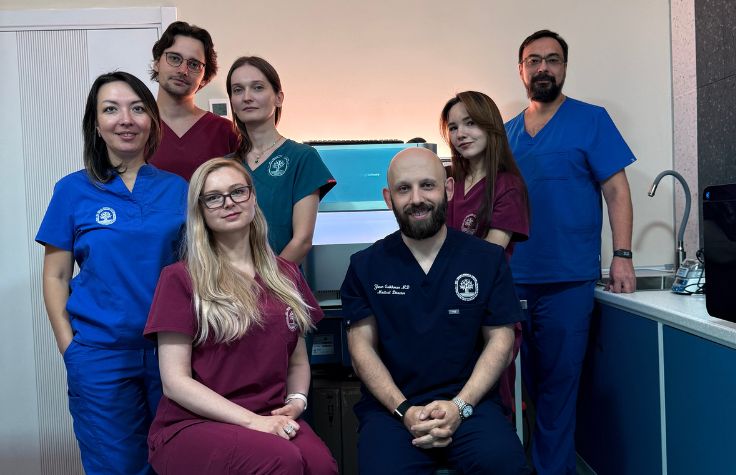
November 18, 2021
“Mostly, by the time a patient is sitting down in front of me, they know they have cancer, and they want to do something about it,” said Dr. Ashish Saxena, a medical oncologist who focuses primarily on lung cancers at New York-Presbyterian Hospital/Weill Cornell Medical Center. The center has implemented Comprehensive Genomic Profiling (CGP), a test that looks at 300 or more cancer-causing genes to identify biomarkers that are associated with groundbreaking therapies, which can readily be prescribed to treat cancer patients.
When CGP testing first debuted in 2012, only a few central labs could process the biopsy samples. Getting results took weeks. Now more and more institutions like Weill Cornell, whose CGP assay is New York state-approved, are bringing the lab under the same roof as the clinic, closer to the patient being tested. That means providing results much faster—a big advantage because any kind of waiting or rescheduling “can obviously be nerve-wracking for the patients. CGP in-house actually gives me time to get the results and figure out what I’m going to do with them,” said Dr. Saxena, who is also an assistant professor of medicine at Weill Cornell Medical College in New York City.

During the Association for Molecular Pathology (AMP) 2021 Digital Experience, Dr. Saxena and his colleague, Dr. Wei Song, a pathologist and the director of the molecular pathology division, as well as the director of the Clinical Genomics Laboratory at Weill Cornell Medicine, sat down to discuss the impact of implementing CGP assays at their institution. The workshop was entitled, “Implementing Comprehensive Genomic Profiling In-house, From a Pathologist’s and an Oncologist’s Point of View.” The session was moderated by Prithwish Pal, Associate Director in Global Medical Affairs at Illumina.
In 2017, Weill Cornell Medicine and New York Presbyterian/Weill Cornell Medical Center launched a next-generation sequencing pipeline for whole-exome sequencing. In successive years, they launched three additional NGS pipelines: one for testing solid tumors (143 genes), a Myeloid panel (48 genes), and finally one for reflex testing of solid tumors (500+ genes). Currently, they see about 3,000 cases annually.
“Over four years, I have learned that in-house testing has a very high percentage of success,” said Dr. Song. “Our DNA test success rate is 98 percent. And our RNA success rate is 94 percent. Those rates, and the faster turnaround time—about seven to 10 working days—and deep communication between pathologists and oncologists [have proved beneficial].”
“I think for a lot of us, the real benefit is in the rapid and the easy communication that we have with our molecular pathologists and pathologists in real time,” said Dr. Saxena. He is able to bypass contacting an outside lab, confirming receipt, making sure they’re working on it, and asking if there’s enough tissue or whether they feel another biopsy is needed. “Because it’s very frustrating as an oncologist and especially for the patient to have them come and say, ‘Well, actually it wasn’t able to be done.’” Dr. Saxena can learn when the results will be ready, schedule appointments accordingly, and get preliminary information. “I can prepare appropriately for the conversation with the patient and explain to them how they’re going to be treated.”
Another advantage is being able to test multiple samples. Drs. Saxena and Song had an elderly patient who had multiple tumor nodules in the right upper lobe of her lung. “The question became, are these separate primary lung cancer nodules or are they the same tumor metastasizing within the same lobe of the lung?” said Saxena. “This is important for me as an oncologist, because the answer will determine what treatment I’m going to recommend for the patient.”
The pathology showed that the tumor nodules were of the same histopathologic type—they were all Invasive Adenocarcinomas. The largest was 2.2 centimeters and there were no regional lymph node metastases involved. But were these separate primary lesions?
“It wasn’t totally clear. But we were able to do an in-house comprehensive genomic panel testing on all three specimens,” said Dr. Saxena. “This particular patient had actually also gone to another institution. I spoke with the oncologist there and she couldn’t believe that we were able to get all three specimens separately profiled. They were using a send-out test there.”
The results showed that tumor specimens one and three had the same mutation but specimen two had a separate genomic profile. That meant metastases and the patient in fact had stage 2B non-small cell lung cancer.
Another patient also had a nodule in her lung. The initial in-house, amplicon-based panel with 161 genes detected no mutations, which was unusual, Dr. Saxena explained, because the woman was in her early thirties and had never smoked. So they did a hybrid capture CGP, a 500-plus gene panel. They found a RET fusion mutation that would respond to targeted RET therapies. “This new CGP 500 panel has a different fusion detection method. The hybrid capture is superior to the amplicon-based method in that it can detect any fusion,” said Dr. Song. “DNA-based fusion detection might miss some of the fusions. RNA-based fusion detection will prove itself. This is one of the best fusion detections in this field.”
The presence of fusions and mutations, detected only through CGP, determine a patient’s eligibility for a targeted drug or clinical trial. It’s these clinical trials, as well as other studies and research, that are “extremely important” to a teaching hospital like Weill Cornell. CGP produces the data that initiates the trials and research that leads to improved patient outcomes. “Some studies are open to anyone in a particular stage but more and more studies are focused on a particular genomic subtype or aberration,” said Dr. Saxena. “We have all this data so we can show that we have this many patients with the mutation that the company or the person running a trial is interested in.” And, adds Song, “The benefit of in-house tests is that we can compile the data very quickly. Many times, when we would send out a test, it came back with a PDF file. That would take much longer to generate the data.”
But performing CGP in-house is not just about availability of data, but about availability and access to expertise. “I think that that collaboration between the pathologist and the medical oncologist is so important for the research, patient care, and mutual education,” said Dr. Saxena, who described communicating constantly with Dr. Song through email, phone, and sitting on tumor boards together. “I talk with other oncologists and they’re always impressed and envious that I can do these things. It’s harder for them to get the information that they need and get things done. So I really feel grateful that I have Dr. Song and this sort of collaboration, because I know that it’s super valuable for me and it’s not something that everybody has.”
“Likewise, it’s so helpful and important for us to know what our oncologist needs to better improve the treatment,” said Dr. Song. “This kind of interaction is really mutually beneficial.”
As the field of precision oncology is gaining traction, and diagnostics and therapies are developing rapidly, it is exciting to be at the dawn of a new era. “It has been almost one century that we’ve used histology or morphology to define cancer,” said Dr. Song. “I think it is time we use molecular profiling as a language to define cancer.”
To view Illumina’s event page for the AMP 2021 digital experience, click here.
To access on-demand viewing of the above workshop, click here.
To learn more about comprehensive genomic profiling, click here.


